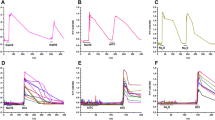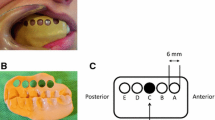Abstract
The effects of local application of capsaicin on the vascular conductance of the oral structures (upper gingiva, lower gingiva, tongue, right and left submandibular glands) were studied with and without pretreatment withN G-nitro-l-arginine methyl ester (L-NAME), a potent inhibitor of nitric oxide formation in rats. Alterations in tissue blood flow were measured by laser-Doppler-flowmetry; systemic blood pressure was monitored continuously during the experiments. Local application of increasing concentrations of capsaicin (1.0; 3.33; 10.0; 33.3 mM; in a volume of 5 μl) resulted in a dose-dependent increase in the vascular conductance of all tissues investigated. There was a significant correlation between the values obtained for vascular conductance in the right and the left submandibular glands. Bolus intravenous injection of L-NAME (10 mg kg−1) elevated the mean systemic blood pressure significantly, by about 20%, with a rapid onset. This increase persisted until the end of the experiment. The augmentation of vascular conductance elicited by 10.0 mM capsaicin, locally administered, was significantly diminished in animals pretreated with L-NAME in all tissues tested. The results indicate that nitric oxide formation plays a significant role in the enhancement of vascular conductance produced in rat oral structures by local capsaicin administration.
Similar content being viewed by others
References
Brain SD, Williams TJ, Tippins JR, Morris HR, MacIntyre I (1985) Calcitonin gene-related peptide is a potent vasodilator. Nature 313:54–56
Dudel C, Förstermann U (1988) Gossypol attenuates selectively the blood pressure lowering effect of endothelium-dependent vasodilators in the rabbit in vivo. Eur J Pharmacol 145:217–221
Fazekas Á, Vindisch K, Pósch E, Györfi A (1990) Experimentally induced neurogenic inflammation in the rat oral mucosa. J Periodont Res 25:276–282
Fazekas Á, Györfi A, Pósch E, Jakab G, Bártfai ZS, Rosivall L (1991) Effect of denervation on the neurogenic inflammation of the rat mandibular mucosa. Naunyn Schmiedebergs Arch Pharmacol 343:393–398
Fiscus RR, Han CD, Wang X (1988) CGRP causes vasorelaxant and CAMP responses in rat caudal artery that is independent of endothelium and prostaglandin synthesis (abstract). FASEB J 2:A1150
Furchgott RF (1983) Role of endothelium in response of vascular muscle. Circ Res 53:557–573
Gallacher DV (1983) Substance P is a functional neurotransmitter in the rat parotid gland. J Physiol (Lond) 342:483–498
Hughes SR, Brain SD (1991) A calcitonin gene-related peptide (CGRP) antagonist (CGRP8–37) inhibits microvascular responses induced by CGRP and capsaicin in skin. Br J Pharmacol 104:738–742
Jancsó N, Jancsó-Gábor A, Szolcsányi J (1967) Direct evidence for neurogenic inflammation and its prevention by denervation and pretreatment with capsaicin. Br J Pharmacol 31:138–151
Kenins P (1982) Responses of single nerve fibres to capsaicin applied to the skin. Neurosci Lett 29:83–88
Kerezoudis NP, Olgart L, Edwall L (1993) Differential effects of nitric oxide inhibition on basal blood flow and antidromic vasodilation in rat oral tissues. Eur J Pharmacol 241:209–219
Krejcy K, Schwarzachter S, Raberger G (1993) Distribution and metabolism of NG-nitro-l-arginine and NG-nitro-l-arginine methylester in canine blood in vitro. Naunyn Schmiedebergs Arch Pharmacol 347:342–345
Lundberg JM, Martling AR, Hökfelt T (1988) Airways, oral cavity and salivary glands: classical transmitters and peptides in sensory and autonomic motor neurons. In: Björklund A, Hökfelt T, Owman C (eds) Handbook of chemical neuroanatomy, vol 6. The peripheral nervous system. Elsevier, Amsterdam, pp 391–444
Lundblad L (1984) Protective reflexes and vascular effects in the nasal mucosa elicited by activation of capsaicin-sensitive substance P immunoreactive neurons. Acta Physiol Scand [Suppl] 529:1–42
Lynn B, Ye W, Cotsell B (1992) The actions of capsaicin applied topically to the skin of the raton C-fibre afferents, antidromic vasodilatation and substance P levels. Br J Pharmacol 107:400–406
Palmer RMJ, Ferrige AG, Moncada S (1987) Nitric oxide release accounts for the biological activity of endothelium-derived relaxing factor. Nature 327:524–526
Palmer RMJ, Asthon DS, Moncada S (1988a) Vascular endothelial cells synthesize nitric oxide froml-arginine. Nature 333:664–666
Palmer RMJ, Rees D, Asthon DS, Moncada S (1988b)l-arginine is the physiological precursor for the formation of nitric oxide in endothelium-dependent relaxation. Biochem Biophys Res Commun 153:1251–1256
Rees D, Palmer RMJ, Hodson HF, Moncada S (1989a) A specific inhibitor of nitric oxide formation froml-arginine attenuates endothelium-dependent relaxation. Br J Pharmacol 96:418–424
Rees DD, Palmer RMJ, Moncada S (1989b) Role of endothelium-derived nitric oxide in the regulation of blood pressure. Proc. Natl Acad Sci USA 86:3375–3378
Rees DD, Palmar RMJ, Schulz R, Hodson HF, Moncada S (1990) Characterization of three inhibitors of endothelial nitric oxide synthase in vitro and in vivo. Br J Pharmacol 101:746–752
Richardson D, Qing-Fu H, Shepherd S (1991) Effects of invariant sympathetic activity on cutaneous circulatory responses to heat stress. J Appl Physiol 71:521–529
Rosell S, Olgart L, Gazelius B, Panopoulos K, Folkers K, Hörig J (1981) Inhibition of antidromic and substance P-induced vasodilation by substance P antagonist. Acta Physiol Scand 111:381–382
Saria A, Theodorsson-Norheim E, Gamse R, Lundberg JM (1985) Release of substance P-and substance K-like immunoreactivities from the isolated perfused guinea pig lung. Eur J Pharmacol 106:207–208
Silverman JD, Kruger L (1989) Calcitonin gene-related-peptide immunoreactive innervation of the rat head with emphasis on specialized sensory structures. J Comp Neurol 280:303–330
Sonntag M, Deussen A, Schrader J (1982) Role of nitric oxide in local blood flow control in the anaesthetized dog. Pflügers Arch 420:194–199
Szolcsányi J (1987) Selective responsiveness of polymodal nociceptors of the rabbit ear to capsaicin, bradykinin and ultraviolet radiation. J Physiol (Lond) 388:9–23
Thériault E, Otsuka M, Jessel T (1979) Capsaicin-evoked release of substance P from primary sensory neurones. Brain Res 170:209–213
Wang X, Han C, Fiscus RR (1991) Calcitonin gene-related peptide (CGRP) causes endothelium-dependent cyclic AMP, cyclic GMP and vasorelaxant responses in rat abdominal aorta. Neuropeptides 20:115–124
Author information
Authors and Affiliations
Rights and permissions
About this article
Cite this article
Fazekas, Á., Matheny, J.L., Roth, G.I. et al. Effect of nitric oxide inhibition on capsaicin-elicited vasodilation in the rat oral circulation. Res. Exp. Med. 194, 357–365 (1994). https://doi.org/10.1007/BF02576398
Received:
Accepted:
Issue Date:
DOI: https://doi.org/10.1007/BF02576398




